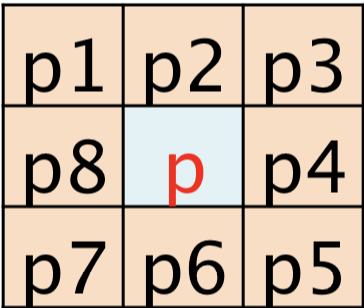simple python program that counts the objects in an image file
Article: S. Levialdi. 1972. On shrinking binary picture patterns. Commun. ACM 15, 1 (January 1972), 7-10.
Levialdi’s shrinking algorithm shrinks every connected component in a binary image to a single isolated point to the upper right corner of its bounding rectangle and erases it.
| Deletion Condition | Augmentation Condition |
|---|---|
| Delete 1-valued-pixel if it has the following neighborhood |
Change a 0-valued-pixel p to a 1-valued pixel if it has a following neighborhood |
In this approach, the image space is partitioned like a checkerboard into two disjoint sets
where 1 and 2 denote the two distinct subfields
Before going into the conditions, we have to define some variables.
- 8-neighbors of the pixel p = Surrounding pixels of p.

p1, p2, p3, ...., pn are 8 neighbors of p.
- B(p) = Number of 1's in pixel p's 8-neighborhood.
- C(p) = Number of distinct sets of 1's in pixel p's 8-neighborhood. (Can be calculated from T(p))
- T(p) = Number of 0-to-1 transition in the 8-neighbors.
For instance;
A pixel p = 1 is deleted
- B(p) = 0 (i.e., isolated point), or
- All of the following conditions are satisfied:
- C(p) = 1
- If B(p) = 1 then p1 = p7 = 0
- p’s 8-neighborhood contains a 3-length or longer run of 4-connected zeros
Examples that satisfy deletion condition can be found at docs/tsf_del_examples.png
A pixel p = 0 is augmented (changed to 1) if both of the following conditions are satisfied
- C(p) = 1
- p8 = p2 = 1 or p8 = p6 = 1
Examples that satisfy augmentation condition can be found at docs/tsf_aug_examples.png
Important Note: In both of the algorithms variable that holds number of objects needs to be incremented every time the programs encounters with an isolated pixel(i.e, all of the 8-neighbors are 0 or B(p) = 0)
Output of the program is a .csv file including file name, which algorithm is used, number of objects and the number of iterations.
| File: NCC16_ITER84.png | Algorithm: Levialdi | NCC: 16 | Iterations: 84 |
|---|---|---|---|
| File: NCC16_ITER84.png | Algorithm: TSF | NCC: 16 | Iterations: 34 |
| File: random-out.jpg | Algorithm: Levialdi | NCC: 32 | Iterations: 12 |
| File: random-out.jpg | Algorithm: TSF | NCC: 32 | Iterations: 6 |
| File: NCC5_ITER48.png | Algorithm: Levialdi | NCC: 5 | Iterations: 47 |
| File: NCC5_ITER48.png | Algorithm: TSF | NCC: 5 | Iterations: 14 |
| File: random-out.jpg | Algorithm: TSF | NCC: 42 | Iterations: 8 |
| File: random-out.jpg | Algorithm: TSF | NCC: 42 | Iterations: 8 |
- delete previous image before opening a new picture
- image saved notification pop-up
- improve the draw feature
- date stamp to the output file
- separate front-end and back-end
All of the images, quoted sentences and materials (excluding .gif's and output.csv) used in README.md are from the slides of Prof. Dr. Muhittin Gokmen




